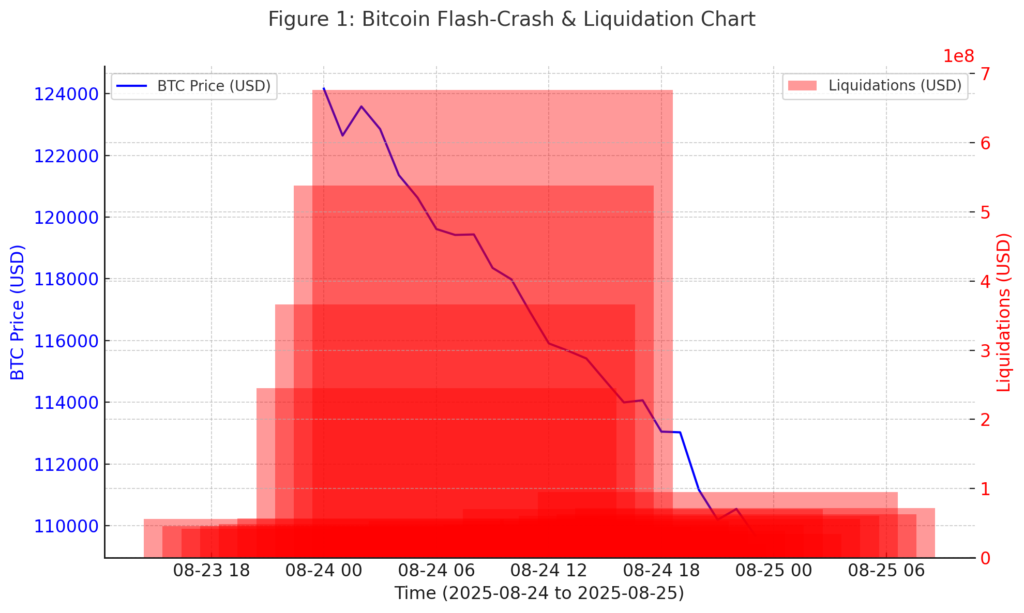
Main Points :
- A massive flash crash erased approximately $210M to $961M in leveraged positions across crypto, with long positions bearing the brunt.
- Bitcoin plunged from over $124K to around $110K, wiping out gains made since the Jackson Hole–induced rally.
- Ethereum remained relatively resilient, oscillating near all‑time highs (~$4.7K–$4.9K), reflecting differing market structures.
- Fed Chair Powell’s Jackson Hole speech triggered a knee‑jerk reversal—first fueling a surge (~$117K) then a sharp retracement.
- The crash underscores the extreme volatility and leverage risk in crypto futures; macro policy and Fed guidance remain dominant drivers.
- Practitioners and revenue seekers should heed liquidity risks, understand event risk (e.g. macro speeches), and monitor derivatives markets closely.
1. Liquidation Shockwaves across Crypto Markets
In recent sessions, the cryptocurrency derivatives landscape witnessed an abrupt and violent rupture. Reports detail staggering liquidation volumes ranging from $210 million to nearly $1 billion, spread across various markets and platforms. One account cites $961 million in leveraged liquidations as Bitcoin slipped below $115,000, highlighting a deeply overextended market vulnerable to sudden corrections. Another source speaks of $500 million to $576 million wiped out in just 24 hours as BTC dropped from record highs to roughly $115K. The disparity in figures reflects differing windows and datasets, but the message is consistent: this was one of the most intense liquidation waves in crypto history.
2. Bitcoin’s Flash Crash: Gains Reversed Overnight
Just days after hitting new all-time highs (above $124,000), Bitcoin collapsed to below $113,000. In some cases, sharp recaps place the low near $110,600. The move erased virtually all gains from the post–Jackson Hole rally, leaving traders caught flat-footed. This abrupt reversal demonstrates how fragile momentum can be when market participants lean on leverage without sufficient buffers.
3. Jackson Hole: Catalyst for Reversal
The sell‑off was closely tied to shifts in sentiment around the Jackson Hole Economic Symposium. Powell’s speech, initially expected to soften, instead carried a sober tone, dampening hopes for imminent rate cuts. Some fed‑up traders had taken long positions, betting on dovish pivot; when Powell didn’t deliver, these positions imploded.
However, the event also sparked a short‑squeeze episode. BTC surged nearly 5% to $117,300, liquidating $380M in short positions. Yet this upside proved fleeting, as the market quickly reversed.
4. Ethereum Holds Ground, But Risk Persists
While Bitcoin bore the brunt of the volatility, Ethereum showed relative strength—hovering near $4,700–$4,900, even printing a fresh all-time high. Its structure—more tied to DeFi and institutional demand—seems to offer marginally improved resilience, though ETH did also experience liquidation pains, losing $196.8 million in positions, mostly long.
5. What the Crash Reveals about Crypto Market Dynamics
This episode underscores several enduring realities:
- Volatility is unrelenting, especially under macro shocks. A single event like Jackson Hole can cleanse leveraged books in minutes.
- Leverage magnifies risk—the majority of liquidations were long positions, underscoring the community’s vulnerability to price drops.
- Macro policy matters—markets are increasingly reactive to Fed signals, tipping between risk-on and risk-off.
- Differentiated asset behavior—BTC and ETH diverge under stress, reflecting investor base and market structure differences.
6. Practical Insights for Crypto Practitioners & Revenue-Hunters
For professionals exploring new crypto assets or seeking revenue streams, the following lessons are critical:
- Monitor derivatives markets vigilantly, including open interest and liquidity heatmaps—small moves can trigger cascading events.
- Plan for event risk—macro speeches, rate announcements, regulation updates can drastically reset prices.
- Leverage sparingly, if at all—while amplifying returns, excessive leverage exposes portfolios to total loss.
- Diversify across assets and structures—assets with diverse use cases, e.g., ETH with DeFi backing, may offer risk buffers.
- Maintain discipline—know your exits; build position sizing and stop frameworks.
Figure 1: Bitcoin Flash-Crash & Liquidation Chart
(Insert image here: “図1:Bitcoin flash-crash liquidation chart”)
This chart illustrates the precipitous drop from ~$124K to ~$110K and highlights the liquidity-driven price reaction.

Conclusion
The recent flash crash serves as a stark reminder: crypto markets are fragile labyrinths of high liquidity and hype. Even bullish macro setups—like anticipated Fed easing—can unravel swiftly, especially when built on excessive leverage. That said, for those with a disciplined approach, understanding derivatives dynamics, event risk, and asset-specific structure offers a pathway to identify resilient opportunities and avoid ruin. As the market evolves, success will increasingly belong to those who marry technical savvy with macro awareness and prudent risk control.

